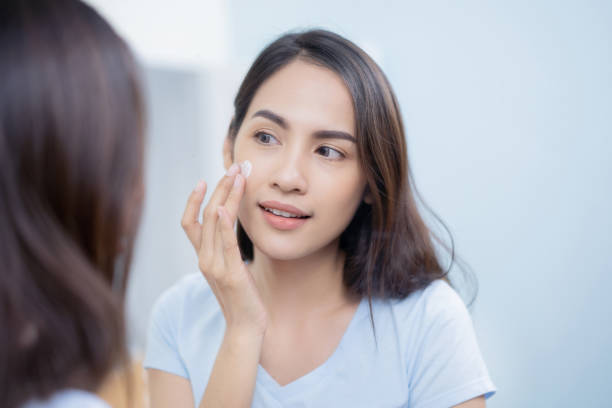Continuous use of chemical skin care products can result in unhealthy skin and acne, dermatitis, eczema and/or psoriasis, premature aging and increased toxin levels in the body. Chemical ingredients can add to the “body-load” of undesirable substances. Further, recent studies have been raising alarm bells about the accumulation of chemicals in the unborn babies.
The following ingredients are commonly used in skin care and cosmetic products. Some have molecules much too large to be absorbed through the skin. Instead, they tend to suffocate the skin and block normal skin respiration by forming a film that traps moisture, toxins and waste while preventing the intake of oxygen.
Some of these chemicals have been implicated in Multiple Chemical Sensitivity.
Phthalates, in particular, are a very serious cause for concern. This is a gender bending; carcinogenic chemical and a common ingredient in hair sprays and skin care.
Chemicals like the synthetic musk found in virtually all chemical deodorants, and perfumed skin-care products are causing serious concern because of the high levels being found in fat tissues.
Let us examine 10 chemical skin care ingredients and their known harmful side-effects.
Lanolin: Extracted from wool and commonly used in skin care and lotions. It may contain residue of pesticides and herbicides. Recent tests conducted on lanolin samples showed up to 26 different chemicals were contaminating this product. Lanolin is now considered a skin sensitive substance that may cause allergic reactions.
DEA, MEA, TEA: These ingredients are used in: cigarettes; shampoo; face cleansers and body wash; soap; bubble bath.
An alarming feature of these ingredients is they are Nitrosamines contaminated, which is a known carcinogen. Large amounts of nitrates can enter the bloodstream after just one shampoo.
Further, a study published by Dr. Samuel Epstein (Professor of Environmental Health at the University of Illinois) reports repeated skin applications of DEA-based detergents resulted in a major increase in the incidence of liver and kidney cancer.
The good news is Europe has acted by restricting their use.
Nitro-sating Agents: Probably, the most potent cancer-causing compound currently used in skin care and is not required to be listed on the ingredient label because it is an impurity.
It contaminates other chemicals, e.g. Formaldehyde; D.M.D.M.; Ammonium Sulfate; Sodium Methyl: DEA, MEA, TEA, PEG.
Nitro-sating compounds are present in tobacco smoke and studies indicate, even in low doses, there is evidence of endocrine disruption.
Further, California EPA Proposition 65 lists as “known to cause cancer and birth defects.”
Regulatory Agencies in Canada and EU has banned it for use in cosmetics.
Petrolatum: Furthermore, known as mineral oil jelly, Vaseline, paraffin, liquid and baby oil. It can lead to photo–sensitivity and strips the natural oils from the skin cause dryness, and premature ageing.
It prevents elimination of toxins, can cause acne and other disorders. The most-recent research has confirmed that during the manufacturing process of petroleum jelly, Nitro amines are formed, which are highly carcinogenic and dangerous to long-term health.
Because of the newest finding’s petroleum or petrolatum, has been banned in the EU. This is an example of a commonly used chemical (40 years or more) now proving to be unsafe and in fact, dangerous to health.
Propylene Glycol: Used in liquid makeup, creams and lotions, including baby lotion. Safety data sheets indicate avoid skin contact; it may cause liver abnormalities and kidney damage and can also be a strong skin irritant?
They have been linked to problems with the immune system; changes the skin’s natural moisture factor; damage’s cell membranes and inhibits cell growth.
These are regularly used as industrial anti-freeze and in brake and hydraulic fluid.
Artificial Musk: Artificial Musk are cheap fragrance ingredients commonly found in the majority of chemical’s skin care products and deodorants. They are also found in shaving creams and after-shave lotions.
These persistent chemicals accumulate in our fat tissue and can be found in breast milk. They play no part in the body and these chemicals will prove to be very dangerous to human health in the long-term.
P.A.B.A: Is found mostly in sunscreens. Like DEA, it is a Nitro-sating forming agent. There is a concern that the energy absorbed by these P.A.B.A using sunscreen is then turned into free radicals, which may actually increase the risk of skin cancer!
Studies show the massive increase in skin cancer, melanoma, directly relates to and is in proportion to the vast increases in sales of chemical based sunscreen products.
Prior to the common use of chemicals on the skin, melanoma rates were static from decade to decade.
Mineral Oil: Derived from petroleum, mineral oil may block normal respiration and suffocate the skin. This ingredient has the potential to cause cancer.
D.M.D.M.: The ingredient is used in body cream and hair products, antiperspirants and nail polish.
This formaldehyde forming preservatives can cause joint pain, allergies, depression, headaches, chest pain, chronic fatigue, and asthma. It can also weaken the immune system and even cause cancer.
Polycyclic Aromatic Hydrocarbons : These ingredients are used in approximately 25% of skin care products such as: baby oils and lotions; hair dyes; shampoo; lipstick; face, body and hand creams.
These ingredients are derived from coal, crude oil and petrol and are another name for toxic chemicals.
US National Toxicology Program list P.H.B as expected carcinogens and California includes P.H.B as a likely carcinogen.
Further, Columbia University researchers found P.H.B at a level 2.6 times greater in females with breast cancer than those that didn’t.
Governments’ don’t have a program to regulate the use of synthetic chemicals. Only 3% of the estimated 90,000 commercial chemicals used to today have been partially tested for safety, according to the article “Cancer,
Inc.” in the September/October 1999 issue of Sierra Magazine.
Acting on a petition filed June 14, 2004 by the Environmental Working Group (E.W.G); on February 3, 2005, the Food and Drug Administration issued an unprecedented warning to the cosmetics industry stating that the Agency is serious about enforcing the law requiring companies to inform consumers about any skin care product which has not been safety tested. In future consumers will be warned in a similar manner to the way cigarette smokers are warned. “Smoking Causes Cancer.” Would you be keen on using a skin care product if it had this prominent warning?: “WARNING – The untested chemicals in this product may cause cancer?”
None of the synthetic chemicals mentioned nor any of the thousands of others in common everyday use, have ever been tested or researched for combined effects. I.e. when one or more chemicals react on the body to each other and cause a combined effect.
Research into the combined effects of chemicals would require the complete commitment and allocation of financial resources from all manufacturers often to their product detriment. The combined effects’ chemicals have on the body are an unknown field and may probably remain this way. As a result, Multiple Chemical Sensitivity is now so common.
Testing for combined effects of chemicals may never happen and consequently, our well-being and that of our children will be the worse. Chemical accumulations in cells and fatty tissues can reach very harmful levels if allowed to continue to a build-up day after day – year after year… Just like the toxic chemicals in tobacco smoke accumulate in the lungs of smokers! We are all aware what damage these causes.
Your skin is no barrier to chemical absorption! The body has no process for excretion of harmful chemicals when the chemicals are absorbed into the blood stream via the skin.
It appears to be clear, when evaluating cosmetic, skin care, beauty products; we should follow these simple steps:
- Read carefully the ingredient label on the back of the product.
- Have an understanding what the ingredient names mean. (The Cosmetic Ingredient Directory A-Z guide)
- Avoid ingredients that have questioned marks about their safety or there is strong ongoing debate.
- Look for products, which contain ingredients that are: Skin compatible; Skin tolerant and work in harmony with the skins’ natural system to deliver effective product performance.
There are many products, which have ingredients, which fit these criteria. Why would you want to use products containing ingredients that additional examination may discover to be harmful to our health?
“WHY TAKE UNNECESSARY RISKS?”
NB: The information contained in this article is not meant to be a replacement or substitute for medical advice. If you have a question or concern regarding any information in this article, please consult your Doctor or Medical specialist.




